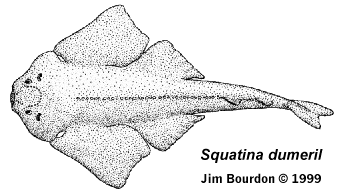| |
Compagno et al (2005: 137-149) includes 18 extant members of this genus, each of which has a limited range. These are moderately sized sharks reaching 1.5 - 2.0 meters in length. Angel sharks are broadly distributed from cold northern boreal waters to the tropics, and can be found at intertidal to upper continental slope depths. Although some species are active at night, they are bottom dwellers that will ambush from buried positions in mud or sand using highly protrusible, trap-like jaws. Two species inhabit North American waters: Squatina californica AYRES, 1859 [Pacific Angel shark] of the Eastern Pacific and S. dumeril LESUEUR. 1818 [Sand Devil] of the Western Atlantic, Gulf of Mexico and Caribbean. Squatina dumeril (to 1.5 m) inhabits near-shore (seasonally) to continental shelf and slope (1300 m) temperate and sub-tropical waters. It feeds on small bottom fishes, crustaceans, and mollusks.
 Not too many vertebrate genera have remained around for 150 million years - Squatina is represented by complete skeletons in Germany's Upper Jurassic (S. acanthoderma FRAAS 1854). In most cases, it is only the teeth of this genus that leave a record through the Mesozoic and Cenozoic.
Not too many vertebrate genera have remained around for 150 million years - Squatina is represented by complete skeletons in Germany's Upper Jurassic (S. acanthoderma FRAAS 1854). In most cases, it is only the teeth of this genus that leave a record through the Mesozoic and Cenozoic.
 Teeth from both jaws of this clutching dentition, and various files, are relatively similar (weak monognathic and dignathic heterodonty). In general, anterior teeth have higher cusps and concave basal root faces. In more distal positions, the cusp becomes lower, the tooth meso-distally elongated, and the root flatter. The cusp is usually slender, with a long, laterally compressed apron and elongated shoulders. The cusp is directed perpendicularly to the basal face of the root. Cappetta (1987: 68-69) indicated that teeth of the genus reach 1.0 cm in width. The list of species and occurrences he provides suggests a genus originating in the Jurassic of Europe (Upper Oxfordian, Upper Jurassic of Germany), spreading to what is now eastern North America & Texas in the Cretaceous, into northern Africa in the Paleogene and Asia in the Neogene.
Teeth from both jaws of this clutching dentition, and various files, are relatively similar (weak monognathic and dignathic heterodonty). In general, anterior teeth have higher cusps and concave basal root faces. In more distal positions, the cusp becomes lower, the tooth meso-distally elongated, and the root flatter. The cusp is usually slender, with a long, laterally compressed apron and elongated shoulders. The cusp is directed perpendicularly to the basal face of the root. Cappetta (1987: 68-69) indicated that teeth of the genus reach 1.0 cm in width. The list of species and occurrences he provides suggests a genus originating in the Jurassic of Europe (Upper Oxfordian, Upper Jurassic of Germany), spreading to what is now eastern North America & Texas in the Cretaceous, into northern Africa in the Paleogene and Asia in the Neogene.
The conservative nature of the Squatina dentition makes it very difficult to identify isolated teeth. Kent (1994: 25-26) suggested that to identify these teeth, the stratigraphic position was required. Looking at the regional nature of extant species, I would tender the opinion that location is also required. Continental placement during the Cretaceous would suggest that the Tethy's species, S. hassei, might be represented in European and North American sediments. However, there would appear to be reason to suspect that by the Miocene, different species were represented on either side of the Atlantic.
Cretaceous
Squatina hassei LERICHE 1929 appears to be the preferred identification for Cretaceous angel shark teeth found in Europe and North America. Schwimmer (1986: 114) reported it from Georgia, Hartstein & Decina (1986: 90) from the Severn of Maryland, Robb (1989: 80) from North Carolina, Welton & Farish (1993: 76-77) from the Campanian and Maastrichtian of Texas. Kent (1994: 25-26) noted that the teeth of this species were small (5 mm) with a short cusp and steeply sloping shoulders - triangular from a labial perspective. Case & Cappetta (1997: 138: pl 5.3-4) ascribed this tooth-design from the Kemp Clay (Maastrichtian) of Texas to Cretorectolobus cf olsoni while acknowledging the difficulty of differentiating these teeth from Squatina. As these specimens compared better with the Squatina tooth-design and following the recommendation of Mikael Siverson (pers. com. 2009), these are included with the angel sharks on the website.
Bourdon et al (2011) in reporting on the Santonian of New Mexico, opted to include those angel shark-like teeth as Parasquatina, a taxa previously reported from Western Europe only.
The angel shark tooth-design is common in the Tar Heel Fm of North Carolina; despite this abundance, they are rarely in very good condition. Interestingly, Case & Cappetta (1997: 135) did not include Squatina in the Maastrichtian of Texas; they attributed teeth of the general angel shark design to Cretorectolobus. With the various caveats associated with this Cretaceous tooth-design from the Western Atlantic, they will be referred to as S. "hassei"
Paleogene
Squatina prima (WINKLER, 1874) is the Paleogene species employed for this genus. Cappetta (1987: 68-69) places it in the Paleocene (Danian-Thanetian) and Eocene (Ypresian) of Morocco, Belgium and England. Kent (1994: 25-26) includes it in the Chesapeake Bay noting its slender crown and low shoulders.
Neogene
Squatina subserrata MÜNSTER 1846. Originally described from the Miocene of Austria, S. subserrata has become a "bucket" for Neogene angel sharks. Kent (1994: 25-26) noted that S. occidentalis (EASTMAN, 1904) had been described from Maryland, "but this appears to be a junior synonym of S. subserrata". Kent goes on to point out that these teeth have been found in Oligocene and Miocene deposits and describes them as being more robust than S. prima. The Miocene teeth from Sharktooth Hill in California still carry the name Squatina lericheii JORDAN & BEAL, 1913, but Itoigawa et al (1985) only referred to the Japanese teeth as Squatina sp. Müller (1999: 33) attributed Oligocene (Old Church Fm., VA) and Miocene (Calvert Fm., MD) to subserrata and Yorktown Fm (Pliocene, NC) specimens from Lee Creek to S. aff dumeril.
Angel shark teeth (currently referred to by the author as S. "subserrata") are relatively common in basal Yorktown (Lower Pliocene) deposits at Lee Creek. John Paschal had extraordinary fortune in the spring of 1998 when he found the first of 87 teeth from an associated dentition. Purdy et al (2001: 97-98) were reluctant to ascribe these teeth to a particular species (probably a good idea) and attributed them to Pungo River (units 4,5) and Yorktown (units 1 & 2) sediments.
Selected References
Bourdon, J., Wright, K., Lucas, S.G., Spielmann, J.A. and Pence, R., 2011. Selachians from the Upper Cretaceous (Santonian) Hosta Tongue of the Point Lookout Sandstone, central New Mexico. New Mex. Mus. Nat. His. and Sc., Bulletin 52; 54pp.
Cappetta, H., 1987. Chondrichthyes II. Mesozoic and Cenozoic Elasmobranchii. In: Handbook of Paleoichthyologie, vol. 3b, Gustav Fischer Verleg, Stuttgart, 193 pp.
Case, G. and Cappetta, H.. 1997. A new selachian fauna from the late Maastrichtian of Texas. Münchener Geowissenschaften Abhandungen 34:131-189.
Compagno, L,, Dando & M., Fowler, S., 2005. Sharks of the World. Harper Collins, 368 p.
Hartstein, E. and Decina, L., 1986. A new Severn Formation (Early Middle Maastrichtian, Late Cretaceous) locality in Prince Georges County, Maryland. The Mosasaur. Delaware Valley Paleontological Society. pp 87-96.
Itoigawa, J., Nishimoto, H., Karasawa, H. & Okumura, Y., 1985. Miocene fossils of the Mizunami group, central Japan. 3. Elasmobranchs. Monograph of the Mizunami Fossil Museum, 5, pp 1-99.
Kent, B., 1994. Fossil Sharks of the Chesapeake Region. Egan Rees & Boyer, Maryland. 146 pp
Müller, A. 1999. Ichthyofaunen aus dem atlantischen Tertiär der USA. Leipziger Geowissenschafteb, Leipzig, 9/10: 1-360.
Purdy, R., Schneider, V., Appelgate, S., McLellan, J., Meyer, R. & Slaughter, R., 2001. The Neogene Sharks, Rays, and Bony Fishes from Lee Creek Mine, Aurora, North Carolina. In: Geology and Paleontology of the Lee Creek Mine, North Carolina, III. C. E. Ray & D. J. Bohaska eds. Smithsonian Contributions to Paleobiology, No 90. Smithsonian Institution Press, Washington D.C. pp. 71-202.
Robb, A., 1989. The Upper Cretaceous (Campanian, Black Creek Formation) fossil fish fauna of Phoebus Landing, Bladen County, North Carolina. The Mosasaur. Delaware Valeey Paleontological Society. pp 75-92.
Schwimmer, D., 1986. Late Cretaceous fossils from the Blufftown Formation (Campanian) in western Georgia. The Mosasaur. Delaware Valeey Paleontological Society. pp 109-119.
Welton, B. and Farish, R., 1993. The Collector's Guide to Fossil Sharks and Rays from the Cretaceous of Texas. Before Time, Texas. 204 pp.
|